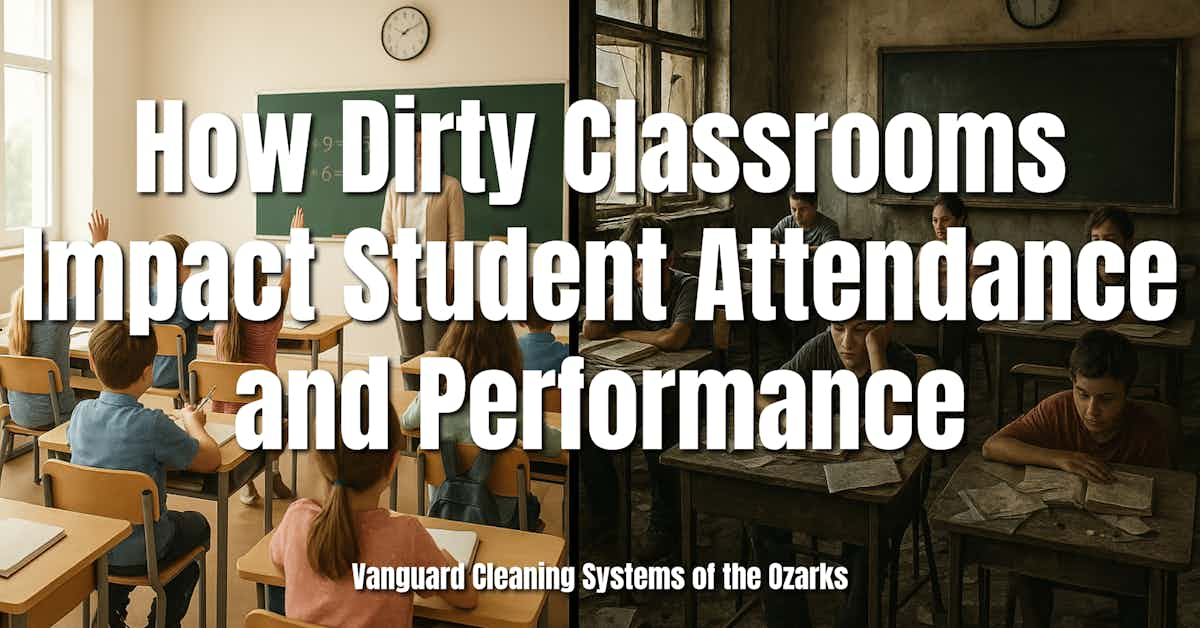Dirty classrooms silently sabotage attendance, behavior, and learning outcomes every day.

The Overlooked Cost of Dirty Classrooms on Student Success
Schools are meant to be safe, focused environments—but when classrooms are neglected, learning suffers. Dirty, cluttered, or poorly ventilated classrooms don’t just look unprofessional—they actively undermine education. The decline in student attendance, attention, and academic performance can often be traced back to poor environmental conditions that go unaddressed.
What the Data Shows:
- Air Quality Affects Attendance
Classrooms with high carbon dioxide (CO₂) levels—often a result of poor ventilation—show measurable drops in student attendance. A 1000 ppm rise in CO₂ correlates with a 0.5–0.9% decline in daily attendance, reflecting a 10–20% relative increase in absenteeism (Shendell et al., 2004). - Invisible Pollutants Impact Behavior
In one case study, students in a classroom exposed to high-frequency electrical pollution became calmer and more attentive after filters were installed, demonstrating how even unseen environmental contaminants can alter learning behavior (Milham, 2011). - Environment Signals Expectations
When a classroom is dirty, disorganized, or physically neglected, students internalize those signals. Studies show that environments lacking structure and cleanliness reduce engagement, increase distraction, and contribute to academic apathy (Achilike, 2015). - Presence Alone Isn't Enough
Simply being in the room doesn’t equate to learning. Sick students, distracted by environmental discomforts, may be physically present but mentally absent—leading to knowledge gaps, behavioral problems, and poor outcomes.
Cleanliness is more than a cosmetic issue in education. It’s foundational to the physical, psychological, and cognitive conditions necessary for learning. When classrooms are clean, well-ventilated, and purposefully arranged, students attend more, behave better, and learn more effectively.
Make Clean Classrooms a Priority
Discover how Vanguard Cleaning Systems® of the Ozarks supports healthier schools with customized janitorial programs tailored for educational facilities.
Environmental Factors That Disrupt Cognitive Performance
The connection between physical classroom conditions and cognitive performance is more than theoretical. Environmental stressors—seen and unseen—alter brain function, concentration, and behavioral stability.
1. Airborne Pollutants Impair Focus
- Elevated levels of CO₂, mold spores, and fine particulate matter reduce oxygen availability to the brain.
- Symptoms include fatigue, slowed response times, and difficulty concentrating.
- Students in poorly ventilated rooms exhibit higher rates of inattention and drowsiness during instruction.
2. “Dirty Electricity” and Neural Overload
- High-frequency electromagnetic pollution—often from outdated electrical wiring or overloaded circuits—has been linked to behavioral disruptions.
- After reducing this “dirty electricity” in classrooms, researchers observed significant drops in hyperactivity and disruptive behavior (Milham, 2011).
3. Cluttered Spaces Increase Cognitive Load
- Overfilled bulletin boards, piles of unused equipment, or scattered materials split attention.
- Visual clutter increases stress and impairs working memory—particularly in younger learners or those with ADHD.
4. Disrepair Creates Distraction
- Flickering lights, stained ceilings, broken tiles, and dirty desks subtly communicate neglect.
- These elements create sensory discomfort, erode discipline, and can trigger subconscious avoidance behaviors, leading to higher absenteeism and mental disengagement.
5. Temperature and Lighting Fluctuations
- Poor climate control and inconsistent lighting affect neurotransmitter function and energy levels.
- Studies have shown optimal learning occurs in well-lit, thermally stable classrooms; dirt, dust, and broken infrastructure interfere with both.
Classroom Design and Management
A clean classroom is only one part of a healthy learning environment. The structure, layout, and maintenance of that environment work together to shape student behavior, attention, and participation.
1. Layout Shapes Learning
- Circular and flexible seating arrangements improve focus, reduce cheating, and foster collaboration.
- Students perform better in organized, thoughtfully arranged spaces that minimize distraction and maximize visibility and interaction.
2. Neglect Signals Low Expectations
- Broken fixtures, stained floors, and outdated furniture communicate a lack of care.
- This environment reinforces the belief that school is not a place that demands respect—resulting in disengagement and discipline issues.
3. Clutter and Poor Design Undermine Control
- Teachers struggle to maintain order in messy, cramped classrooms.
- Disorder erodes authority and makes consistent behavioral expectations harder to enforce.
4. Acoustics and Lighting Matter
- Dim lights, echoing rooms, or flickering bulbs affect sensory processing.
- Poor acoustics make it harder for students to follow instruction, particularly for language learners and those with learning differences.
5. Clean Spaces Build Classroom Culture
- Cleanliness reinforces structure. Structured spaces help reinforce routines.
- When students see clean desks, aligned supplies, and organized materials, they internalize a message of order and readiness.
Attendance as a Predictor of Academic Performance
Student success begins with showing up—but it doesn’t end there. Clean, well-managed classrooms drive consistent attendance, which in turn fuels better learning outcomes. When the environment suffers, attendance drops—and performance declines with it.
1. Consistent Attendance Drives Skill Acquisition
- In skill-based programs like business education, attendance is critical for mastering complex, hands-on tasks.
- Students who attend regularly gain exposure to instructional time, classroom discussions, and guided practice that cannot be replicated asynchronously.
2. Dirty Classrooms Encourage Absenteeism
- Odors, unclean bathrooms, visible grime, and clutter give students subconscious permission to skip.
- Parents of younger students may also choose to keep children home due to concerns about hygiene and health risks in visibly unclean spaces.
3. Physical Presence ≠ Learning
- A sick, distracted, or uncomfortable student may be seated at a desk but mentally disengaged.
- Environments that are noisy, chaotic, or physically unpleasant reduce focus and retention, even when students are technically “present.”
4. Teacher Absenteeism Triggers Student Absenteeism
- In environments where staff are frequently absent—often tied to institutional dysfunction and poorly maintained facilities—students are more likely to disengage.
- Clean, organized classrooms correlate with better teacher morale and more consistent instruction.
5. Poor Attendance = Poor Outcomes
- Students with high absenteeism consistently show:
- Lower test scores
- Weaker graduation rates
- Higher disciplinary incidents
- These effects compound year over year, especially in environments where cleanliness and order are not prioritized.
Institutional and Cultural Barriers to Maintaining Clean Classrooms
Maintaining a clean and orderly classroom isn’t just about individual habits—it’s shaped by larger institutional forces. Schools that lack the funding, policies, or leadership to enforce cleanliness often see the consequences in student performance and staff morale.
1. Budget Constraints Undermine Sanitation
- Schools in underfunded districts often lack adequate custodial staff, cleaning supplies, or building maintenance resources.
- Deferred maintenance—like broken HVAC systems, leaky ceilings, or pest infestations—leads to chronic environmental degradation.
2. Administrative Instability Fuels Neglect
- Inconsistent leadership, frequent staff turnover, or unclear operational roles cause daily cleaning and maintenance routines to collapse.
- Teachers are often forced to spend time managing cleanliness—distracting from instructional duties and degrading professional morale.
3. Cultural Tolerance of Low Standards
- When dirty conditions are normalized, both students and staff lower their expectations for behavior, attendance, and academic rigor.
- A culture of neglect creates apathy and reduces the perceived importance of participation and effort.
4. Technology Use Without Boundaries
- In poorly managed classrooms, devices like smartphones often become escape tools for students—especially in uncomfortable or chaotic environments.
- Lack of digital boundaries and classroom control exacerbates disengagement and academic underperformance.
5. Lack of Accountability in Facility Management
- No clear chain of responsibility often leads to blame diffusion—everyone sees the dirt, but no one is tasked with resolving it.
- Without consistent protocols or cleanliness standards, even well-intentioned staff struggle to maintain an effective learning environment.
Frequently Asked Questions About Classroom Cleanliness and Student Performance
What impact does classroom cleanliness have on student attendance?
Classroom cleanliness affects student attendance by influencing comfort, health, and perceived safety. Poor air quality and visible neglect lead to more absences and lower parental confidence in school hygiene.
Can a messy classroom affect student learning?
Yes. Cluttered or dirty classrooms increase cognitive load, reduce focus, and disrupt behavioral control, all of which negatively impact academic performance.
Is there a connection between ventilation and classroom performance?
Absolutely. Studies link poor ventilation—often found in unclean classrooms—to increased CO₂ levels, which reduce attentiveness and raise absenteeism rates.
Why do teachers avoid teaching in dirty classrooms?
Dirty classrooms affect teacher morale, increase stress, and distract from instructional responsibilities, leading to higher rates of absenteeism and burnout among educators.
References
- Shendell, D., Prill, R., Fisk, W., Apte, M., Blake, D., & Faulkner, D. (2004). Associations between classroom CO2 concentrations and student attendance in Washington and Idaho.. Indoor air, 14 5, 333-41 . https://doi.org/10.1111/J.1600-0668.2004.00251.X
- Milham, S. (2011). Attention deficit hyperactivity disorder and dirty electricity.. Journal of developmental and behavioral pediatrics : JDBP, 32 8, 634 . https://doi.org/10.1097/DBP.0b013e31822f8da7
- Adaku Achilike. (2015). Business education students attendance and effective classroom management. 9 (1). https://www.researchgate.net/publication/280977864_Business_education_students_attendance_and_effective_classroom_management
Conclusion
A dirty classroom is more than an aesthetic issue—it’s a barrier to learning. The data shows that unclean, poorly ventilated, and disorderly environments lower attendance rates, disrupt concentration, and weaken academic outcomes. Students are less likely to attend class when the physical space feels neglected, and even when they do, their ability to focus, behave, and absorb information is compromised.
Clean classrooms support more than hygiene—they reinforce structure, expectations, and educational purpose. When schools invest in clean, organized learning environments, they do more than tidy up—they make a direct investment in student attendance, behavior, and long-term performance.
Vanguard Cleaning Systems® of the Ozarks' franchise-owned custodial service provider business cleans more than 8M sq. ft. weekly, maintaining an industry-topping 95+% of its customer base, year-over-year, and boasting more than 60 5-star Google reviews.
Need more capability from your vendor partners? --Let's talk.
In Oklahoma, dial 918-960-4450
In Arkansas, dial 479-717-2410
In Missouri, dial 417-812-9777

